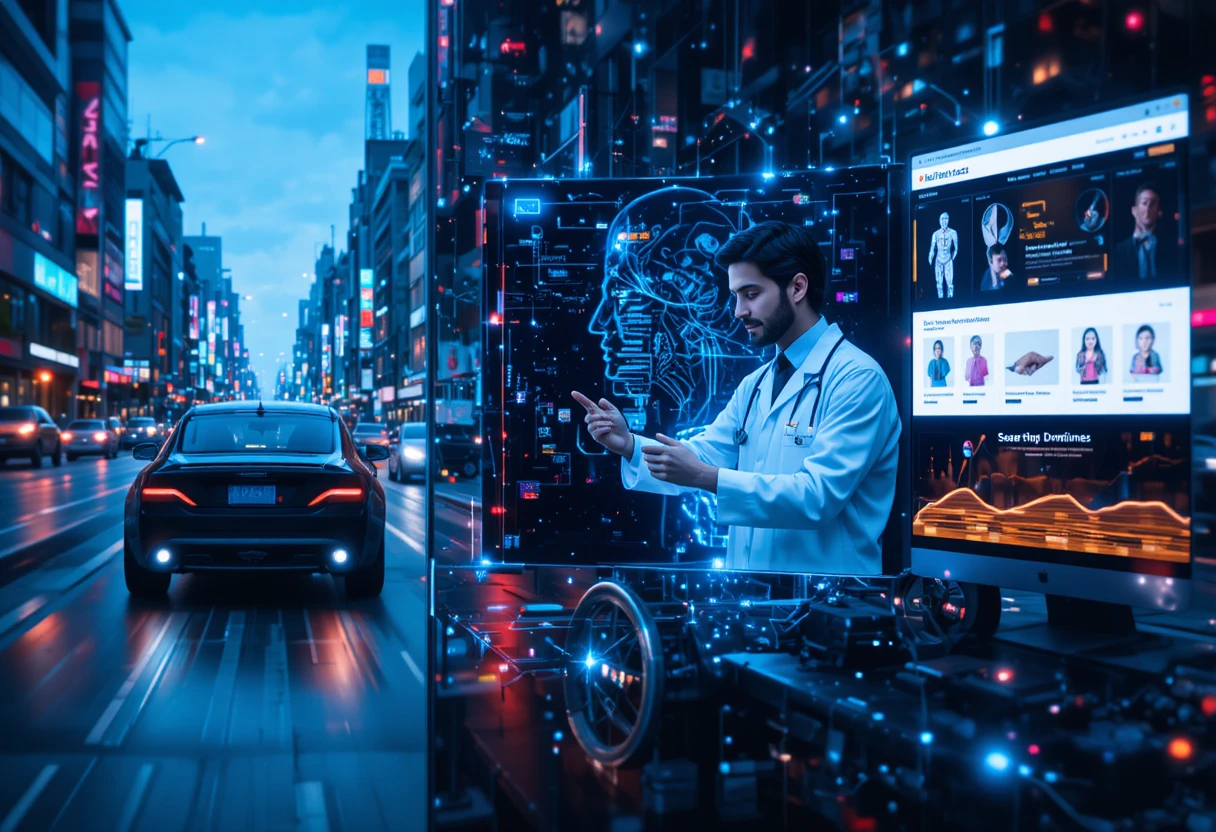Machine learning (ML), a subset of artificial intelligence, has emerged as a transformative force in the digital age, enabling systems to learn from data and make decisions with minimal human intervention. As of October 2025, ML drives innovations across industries, from healthcare diagnostics to autonomous vehicles, reshaping how we interact with technology and the world. This 3000-word post explores the essence of machine learning, its history, algorithms, applications, benefits, challenges, current trends, and future potential, providing a comprehensive guide to its impact on society.
What Is Machine Learning?
Machine learning is the science of enabling computers to learn patterns and make predictions or decisions from data without being explicitly programmed. Unlike traditional software, where rules are hardcoded, ML models improve through experience, adapting to new information. For example, a spam email filter learns to identify junk mail by analyzing patterns in millions of emails.
Core Components of Machine Learning
ML systems rely on three pillars:
- Data: The fuel for learning, ranging from structured datasets (e.g., spreadsheets) to unstructured data (e.g., images, text).
- Algorithms: Mathematical models like decision trees or neural networks that process data to find patterns.
- Compute: Powerful hardware, such as GPUs and TPUs, to handle complex calculations.
Types of Machine Learning
ML is categorized into:
- Supervised Learning: Uses labeled data to predict outcomes (e.g., predicting house prices).
- Unsupervised Learning: Finds patterns in unlabeled data (e.g., customer segmentation).
- Reinforcement Learning: Learns through trial and error, optimizing actions based on rewards (e.g., game-playing AI).
- Semi-Supervised and Self-Supervised Learning: Combines labeled and unlabeled data for efficiency.
The History of Machine Learning
Machine learning traces its roots to the dawn of computing, evolving from theoretical concepts to practical applications.
Early Foundations
In 1950, Alan Turing posed the question, “Can machines think?” in his seminal paper, laying the groundwork for AI and ML. In 1952, Arthur Samuel developed a checkers-playing program that improved through self-play, coining the term “machine learning.” The 1960s saw the creation of the perceptron, an early neural network model by Frank Rosenblatt.
The AI Winter and Resurgence
The 1980s introduced backpropagation, enabling multi-layer neural networks, but computational limits and data scarcity led to the “AI winter.” The 1990s brought practical successes like IBM’s Deep Blue defeating chess champion Garry Kasparov in 1997.
The Deep Learning Revolution
The 2010s marked a turning point with big data, powerful GPUs, and breakthroughs like AlexNet (2012), which dominated image recognition tasks. By 2016, Google’s AlphaGo defeated world champion Lee Sedol, showcasing reinforcement learning’s power. By 2025, ML is ubiquitous, powering everything from voice assistants to autonomous robots.

How Machine Learning Works: The Technical Foundations
Machine learning operates through a cycle of data collection, model training, and deployment.
The ML Pipeline
- Data Collection and Preprocessing: Raw data is cleaned, normalized, and labeled. For example, image data is resized, and missing values are imputed.
- Model Selection: Algorithms like linear regression, support vector machines, or deep neural networks are chosen based on the task.
- Training: The model learns by minimizing errors (e.g., using gradient descent) on a training dataset.
- Evaluation: Performance is tested on validation data using metrics like accuracy or F1 score.
- Deployment and Monitoring: Models are deployed in production, with continuous updates to handle data drift.
Key Algorithms
- Linear Regression: Predicts continuous values (e.g., stock prices).
- Decision Trees and Random Forests: Classify data by branching decisions.
- Neural Networks: Mimic human brains for tasks like image recognition.
- Transformers: Power natural language processing (NLP) in models like GPT-4.
Hardware and Frameworks
GPUs from NVIDIA and TPUs from Google accelerate training. Frameworks like TensorFlow, PyTorch, and Scikit-learn simplify development. Cloud platforms like AWS SageMaker and Google Vertex AI enable scalable ML deployment.
Types of Machine Learning Applications
Machine learning’s versatility spans numerous domains, transforming industries with data-driven solutions.
Healthcare
ML predicts diseases, personalizes treatments, and automates diagnostics. For example, Google’s DeepMind analyzes retinal scans to detect diabetic retinopathy with 90% accuracy.
Finance
Fraud detection systems use anomaly detection to flag suspicious transactions. JPMorgan’s COiN platform processes legal documents, saving thousands of hours.
Retail and E-Commerce
Recommendation engines, like Amazon’s, analyze user behavior to suggest products, driving 35% of sales. Price optimization models adjust dynamically based on demand.
Autonomous Systems
Self-driving cars from Waymo and Tesla rely on ML for object detection and path planning. Drones use reinforcement learning for navigation.
Entertainment and Media
Netflix’s recommendation system and Spotify’s playlist curation use ML to personalize content. Generative AI creates music, art, and even movie scripts.

Benefits of Machine Learning
Machine learning offers profound advantages, reshaping economies and societies.
Automation and Efficiency
ML automates repetitive tasks, saving time. For instance, chatbots handle 70% of customer queries in real-time, reducing costs.
Enhanced Decision-Making
Predictive analytics informs strategies. Retailers use ML to forecast inventory needs, reducing waste by up to 30%.
Personalization
ML tailors experiences, from targeted ads to customized healthcare plans, improving user satisfaction.
Scalability
Cloud-based ML handles massive datasets. Google’s BigQuery processes petabytes of data for analytics in seconds.
Innovation Catalyst
ML democratizes access to advanced tools. Small startups leverage AWS or Azure to build AI solutions without massive infrastructure.
Challenges and Limitations of Machine Learning
Despite its promise, ML faces significant hurdles that require careful navigation.
Data Quality and Bias
Poor data leads to inaccurate models. Biases in datasets, like facial recognition systems misidentifying minorities, raise ethical concerns. In 2024, a biased hiring algorithm sparked controversy, highlighting the need for fairness audits.
Computational Costs
Training large models, like transformers, requires immense compute power, costing millions. For example, training GPT-3 consumed energy equivalent to 120 households for a year.
Interpretability
“Black box” models, like deep neural networks, are hard to explain, posing challenges in regulated fields like healthcare and finance.
Data Privacy and Security
ML systems handling sensitive data risk breaches. GDPR and CCPA impose strict regulations, with fines reaching €20 million for non-compliance.
Overfitting and Generalization
Models may perform well on training data but fail in real-world scenarios, requiring techniques like regularization to improve robustness.
Current Trends in Machine Learning (2025)
As of 2025, ML is evolving rapidly, driven by breakthroughs and societal demands.
Generative AI
Models like DALL-E 4 and Stable Diffusion create hyper-realistic images, videos, and text. OpenAI’s o1 model excels in reasoning, solving complex math problems.
Edge AI
ML on edge devices, like smartphones and IoT sensors, reduces latency. Qualcomm’s Snapdragon chips power on-device AI for real-time translation.
Automated Machine Learning (AutoML)
Platforms like Google AutoML simplify model-building for non-experts, democratizing AI.
Sustainable AI
Energy-efficient algorithms and green data centers address ML’s carbon footprint. Google aims for carbon-neutral AI operations by 2030.
Multimodal AI
Models combining text, images, and audio, like Google’s Gemini, enable richer applications, such as AI assistants understanding context from videos.
The Impact of Machine Learning on Society and Economy
Machine learning reshapes industries, economies, and daily life.
Economic Growth
The global AI market, driven by ML, is projected to reach $1.8 trillion by 2030. ML creates jobs in data science while automating roles, raising debates about universal basic income.
Social Transformation
ML enhances accessibility, with tools like real-time sign language translation aiding the deaf. However, it risks widening inequalities if access remains uneven.
Industry Disruption
Healthcare sees faster drug discovery via ML simulations. Logistics benefits from predictive maintenance, reducing downtime by 20%.
Ethical Considerations
Misuse of ML, like deepfakes, fuels misinformation. Ethical frameworks, such as IEEE’s AI ethics guidelines, aim to ensure responsible use.

Machine Learning vs. Traditional Programming
Traditional programming relies on explicit rules, while ML learns from data. For example, a traditional spam filter uses predefined keywords, whereas an ML filter adapts to new spam patterns. ML excels in complex, data-rich tasks but requires more data and compute than rule-based systems.
When to Use ML
ML is ideal for tasks like image recognition or predictive analytics, where patterns are hard to codify. Traditional programming suits simple, deterministic tasks.
Case Studies: Machine Learning Success Stories
- Google Translate: Uses transformers to support 130+ languages, handling billions of translations daily.
- Tesla Autopilot: Employs neural networks for real-time object detection, navigating complex driving scenarios.
- AlphaFold: DeepMind’s protein-folding model solved decades-old biological problems, accelerating drug discovery.
The Future of Machine Learning
Looking to 2030, ML will continue to evolve, driven by technological and societal shifts.
Quantum Machine Learning
Quantum computing, via platforms like IBM Quantum, could solve complex optimization problems, revolutionizing fields like cryptography.
General AI (AGI)
While ML today is narrow, AGI—capable of human-like reasoning—may emerge by 2035, with companies like xAI leading efforts.
Ethical AI
Frameworks will enforce transparency and fairness, addressing bias and privacy. Governments may mandate explainable AI in critical sectors.
Edge and Federated Learning
Federated learning, where models train on decentralized devices, will enhance privacy. Apple’s on-device ML for Siri is a precursor.
Sustainability
Energy-efficient algorithms, like sparse models, will reduce ML’s environmental impact. By 2030, AI could cut global emissions by 10% through optimized industries.
Conclusion
Machine learning stands as a pillar of the digital revolution, driving innovation across healthcare, finance, and beyond. Its ability to learn from data unlocks unprecedented efficiency and personalization, but challenges like bias, costs, and ethics demand vigilance. In 2025, trends like generative AI and edge computing signal a dynamic future, with quantum ML and AGI on the horizon. By balancing innovation with responsibility, machine learning can create a world of abundance, enhancing lives while addressing global challenges.